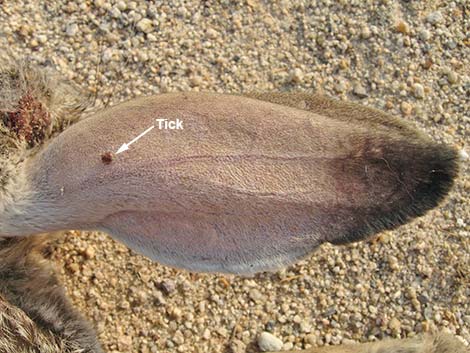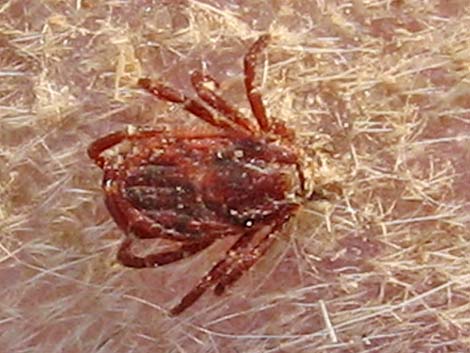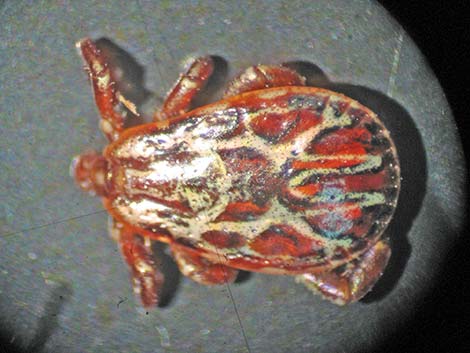
Invertebrates Around Las Vegas, Wildlife Around Las Vegas
 Typical tick on a black-tailed jackrabbit ear (Mojave NP) |
Hard Ticks (Family Ixodidae) Ticks are interesting creatures with complex life cycles. Unfortunately, they bite humans and suck our blood, creeping us out. It is hard to get past this fact, so it is fortunate that few ticks bother humans in the desert and mountains around Las Vegas. With the climate changing, this may not be the case much longer. Hard Ticks have mouth parts that point forward, and they have a hard exterior (or at least a hard dorsal shield). (Compare with Soft Ticks). Hard ticks parasitize a variety of hosts, and depending on the growth stage of the tick, the larvae might feed on one species, the nymphs feed on another, and the adult on something else. When ready to feed, these ticks climb up onto a piece of vegetation that is the right height for the hapless victim. For example, a young tick that wants to feed on a Cactus Mouse might climb onto a short blade of grass, while an adult that wants to feed on a large mammal like a Desert Bighorn Sheep might climb onto a shrub or tall grass stem. In doing this, adult Hard Ticks catch and feed on humans. |
 Tick with head buried in the ear of a black-tailed jackrabbit |
Hard Ticks carry a variety of diseases, but fortunately, most tick bites do not transmit diseases to humans. In part, this is because ticks usually need to be attached for a long time (hours) before diseases are transmitted. Most people have heard of Rocky Mountain Spotted Fever and Lyme Disease, fairly common tick-borne diseases. One particularly horrible tick-borne "disease" is Tick Paralysis. I've seen this in mice, and the thought of it happening to me is enough to keep me awake at night. Tick Paralysis occurs when a tick bites you in the back of the neck at the base of your skull. The tick saliva affects the nervous system and causes total paralysis while the tick is attached. Fortunately, after the tick feeds and drops off, the symptoms disappear, but the nightmares probably last a lifetime. The only place in southern Nevada where I know ticks to be a problem for humans is in the Arrow Canyon Range, where the Hard Tick Dermacentor hunteri seems to be fairly common. I've never seen a tick on a human at Red Rocks, Lake Mead, or Mt. Charleston, places that all have plenty of opportunities for ticks, although there has been at least one case of Lyme Disease on Mt. Charleston. I've also heard of at least one tick in the Black Mountains (Sloan Canyon NCA). |
 This tick, an adult Dermacentor hunteri, usually is found on Desert Bighorn Sheep |
If you find one, try to get a photo so we can confirm the species. If it hasn't yet bit you, it can't quickly do so, so photographing it crawling on your skin won't add any danger. If it has bit you, it takes hours for them to transfer enough disease-causing bacteria to affect you, so again, taking a photo won't add to the danger. One thing you can do to safely keep a tick is trap it inside a folded-over piece of clear tape. Take a piece of scotch tape or clear packing tape, put the tape sticky-side down on the tick and lift if off your skin, then fold the sticky sides of the tape together. Gently press the edge of the tape together and you can keep it as a pet for years. If it is a female, she will lay eggs before she dies. When you tire of your pet, you can toss it (or give it to me). |
Note: All distances, elevations, and other facts are approximate.
![]() ; Last updated 240218
; Last updated 240218
Return to All Ticks.
| Inverts Around Las Vegas | Wildlife Around Las Vegas | Glossary | Copyright, Conditions, Disclaimer | Home |